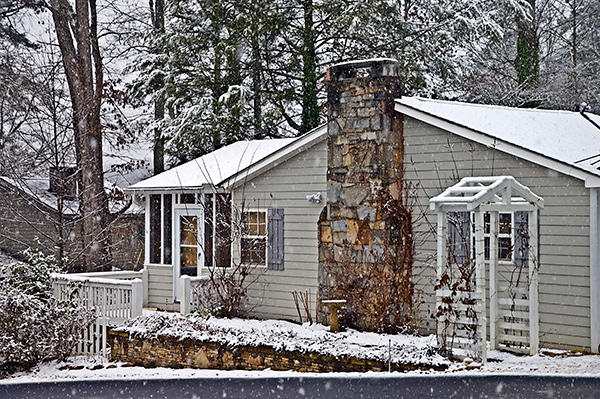
Each year the fall weather sneaks up and it seems as though one minute it is warm and sunny and the next, there’s frost on the ground. The rapid fluctuation in weather is a good indicator that winter is right around the corner. That means it’s time to prepare your chimney for the long, cold season that’s quickly approaching. Here are 5 tips for winter chimney preparations to keep your home, fireplace, and chimney safe and warm in the months to come.
Schedule an Inspection & Cleaning
While it’s true that a few months ago would have been the ideal time to schedule your inspection, don’t use that as an excuse to postpone your chimney inspection until next year! Getting your chimney inspected regularly is the only way to catch issues and address them before they become hazardous. An inspection can catch structural issues such as cracks that could allow moisture into your home, signs of a chimney fire, and combustible deposits that could lead to a chimney fire.
Finding such issues before they lead to further damage is an ounce of prevention that is well worth it; potentially saving you money, your home, or even lives. Even if no structural issues are discovered with your inspection, chimney cleaning will remove debris and dangerous creosote which will allow safe usage of your fireplace or stove all winter long. Winter chimney preparations begin with a cleaning and inspection.
Inspect or Repair Your Chimney Flashing
Winter chimney maintenance and preparation for the cold weather should include inspection of your chimney flashing as well. Chimney flashing is the sheet metal that keeps the space between your roof and chimney protected and watertight.
Over the years, flashing can show signs of aging. If not given the proper attention, flashing can become worn, damaged or rusted. If there are any gaps in your roof or around your flashing, intense weather such as constant rains or snow melt can find ways to sneak in. If left unrepaired, damaged flashing will let moisture seep in. Snowy regions can be hit especially hard and that moisture can lead to mold and damage to the masonry in your chimney.
Regular inspections can catch these aging issues and address them before they get worse. This can help you prevent water damage to your home from leaks due to aging flashing. Having to address leaks due to damaged chimney flashing when there’s six inches of snow on your roof isn’t the most ideal situation. It may not be a part of the chimney many people think about, but you can see why checking the flashing before the snow starts to fall is an important part of any winter chimney preparation.
Have a Gas Fireplace? Check the Blower
The blower of a gas fireplace is a significant part of its function. The blower is what helps gas fireplaces circulate the warm air they produce. This is why they are good for zone heating. However, dust and debris can clog the blower of your gas fireplace. Buildup happens over time, but when you have a clogged blower it can reduce the efficiency of your fireplace. This, in turn, can reduce the amount of heat your fireplace can provide. Clogged blowers can potentially even be a fire risk.
It’s not uncommon for blowers to go long periods of time without being cleaned. They are hidden and out of the way and often forgotten. But don’t let “out of sight, out of mind,” be a reason that you don’t clean your blower before the season. Once fireplace use ramps up, you’ll want to be sure that your gas fireplace is working at peak efficiency for the winter. Make it part of your winter chimney maintenance routine and ensure the safety and efficiency of your gas fireplace.
Ensure Your Chimney Has a Functioning Cap
Your winter chimney preparation checklist isn’t complete without making sure your chimney has a cap that is functioning properly. A chimney cap protects your chimney from many things such as animals, debris and, most importantly, moisture.
Chimney caps are constantly exposed to the elements and, as time goes by, can deteriorate in the same way that chimney flashing can. If your chimney cap is damaged, it can let the moisture from snow or freezing rain build up inside your chimney. The resulting moisture inside your chimney can lead to mold issues. Additionally, because bricks are porous, moisture poses a significant risk for the integrity of the masonry. When it gets inside the bricks and freezes, the resulting expansion creates cracks. Left unaddressed, the cracks get worse over time. The short-term problem is heat that is allowed to escape the chimney. Major chimney failures are a risk if chimney cap issues are ignored over the long-term. According to the Chimney Safety Institute of America, “Chimney caps, also called rain covers, are probably the most inexpensive preventive measure that a homeowner can employ to prevent water penetration and damage to the chimney.”
Triple Check for Masonry Damager
Finally, don’t just check your chimney’s masonry, triple check it. Masonry can be damaged by moisture but there are other sources of potential damage as well. Excessive heat, like what can occur from creosote burning, can damage the bricks in your chimney. Storms can also directly impact your chimney, as can the natural deterioration that results as the years go by. The safety of your chimney is compromised with any loose bricks or mortar that has eroded.
Leaks of heat, or byproducts of combustion, need to be prevented. The best thing to do is check your masonry as part of your regular winter chimney prep to be sure your chimney is free of erosion or loose bricks. Otherwise, you run the risk of losing the use of your fireplace just when you need it most – in the middle of frigid winter temperatures.
Ready for Your Chimney Inspection? Call Doctor Flue!
If you haven’t had a chimney inspection in the last year, or following an event like a chimney fire, contact us today! Doctor Flue offers chimney services in Michigan and Ohio and can inspect your chimney and identify any potential risks. We’ll get you set up right away so you can have peace of mind.
Call Us: 1-800-438-3583
Email Us: office@drflue.com
Office Hours: Mon-Fri: 8am-4pm
Connect with Doctor Flue on Social Media

